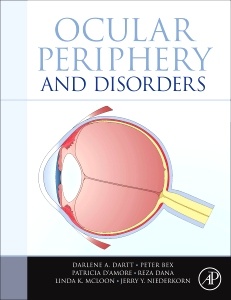Description
Ocular Periphery and Disorders
Coordinators: Dartt Darlene A., Bex Peter, D’Amore Patricia, Dana Reza, Mcloon Linda, Niederkorn Jerry
Language: English
Subjects for Ocular Periphery and Disorders:
Support: Print on demand
Description
/li>Contents
/li>Readership
/li>Biography
/li>Comment
/li>
This selection of articles from the Encyclopedia of the Eye is the first single-volume overview presenting articles on the function, biology, physiology, and pathology of the structures of the ocular periphery, as well as the related disorders and their treatment. The peripheral structures are implicated in a number of important diseases, including optic neuritis, thyroid eye disease, and strabismus. The volume offers a basic science background of these topics rather than a strictly clinical focus.
I. Anatomy and Pathophysiology of Blinking and Eye Movements Eyelid anatomy and the pathophysiology of blinking Differentiation and morphogenesis of extraocular muscles Extraocular muscle anatomy Extracocular muscle metabolism Extraocular muscles: proprioception and proprioceptors Abnormal eye movements due to disease of the extraocular muscles and their innervation Extraocular muscles: functional assessment in the clinic
II. Structure and Function of the Tear Film, Ocular Adnexa, Cornea, and Conjunctiva in Health and Pathogenesis in Disease Meibomian glands and lipid layer Lacrimal gland overview Lacrimal gland hormone regulation Lacrimal gland signaling-neural Lids: Anatomy, pathophysiology, and mucocutaneous junction Ocular surface-overview of electrolyte and fluid transport across the conjunctiva Conjunctival Goblet cells Ocular mucins Tear drainage Cornea overview Corneal epithelium-cell biology and basic science Corneal nerves-anatomy Corneal nerves-function Corneal epithelium-wound healing junctions, attachment to stroma receptors, matrix metalloproteinases, intercellular communications Corneal epithelium-transport and permeability Stem cells of the ocular surface The ocular surface-the surgical treatment for corneal epithelial stem cell deficiency, corneal epithelial defects, and periferal corneal ulcer Refractive surgery Refractive surgery and inlays Contact lenses Imaging of the cornea The corneal stroma Corneal dystrophies Corneal imaging-clinical Corneal scars Corneal endothelium-overview Regulation of corneal endothelial function Regulation of corneal endothelial cell proliferation Artificial cornea Drug delivery to cornea and conjunctiva-esterase- and protease-directed prodrug design Knock-out mice models: cornea, conjunctiva, eyelids, and lacrimal glands Gene therapy
III. Immune Regulation of the Cornea and Conjunctiva and Its Dysregulation in Disease Adaptive Immune System and the Eye: Mucosal Immunity Adaptive immune system and the eye: T-cell mediated immunity Innate immune system and the eye Immunoregulatory processes that sustain immune privilege in the eye Immunosupressive and anti-inflammatory molecules that maintain immune previlege of the eye Antigen-presenting cells in the eye and ocular surface Dry eye: An immune-based inflammation Penetrating keratoplasty Immunopathogenesis of HSV Keratitis Immunopathogenesis of Onchocerciasis (River Blindness) Immunopathogenesis of pseudomonas keratitis Immunobiology of acanthomeba karatitis Molecular and cellular mechanisms in allergic conjunctivitis Pathogenesis of fungal keratitis Conjunctiva Immune surveillance Defense mechanisms of tears and ocular surface Corneal epithelium- response to infection Inflammation of the Conjunctiva Concept of Angiogenic Privilege Corneal angiogenesis Avascularity of the cornea
IV. Visual Acuity Related to the Cornea and Its Disorders Visual optics: pupil Acuity Contrast sensitivity Astigmatism Vera-Diaz- Myopia Levi-Amblyopia Harb- Hyperopia
Students, researchers and practitioners in ophthalmology and optometry, neuroscience, immunology, physiology, cell biology, pharmacology, and related disciplines
Dr. D’Amore is an international expert in vascular growth and development and has been at the forefront of angiogenesis research for over three decades. She has published more than 170 peer-reviewed papers, 75 reviews, and edited or co-edited two books.
In addition to his role as Senior Scientist and Co-Director at the Schepens Eye Research Institute, Dr. Reza Dana holds the Claes H. Dohlman Chair in Ophthalmology at Harvard Medical School. He is Director of the Cornea & Refractive Surgery Service at the Massachusetts Eye & Ear, and serves as the Vice Chairman of the Harvard Department of Ophthalmology and Associate Chief of Ophthalmology for Academic Programs at Massachusetts Eye and Ear. After graduating Summa Cum Laude from St. Paul’s School in New Hampshire, he completed his bachelor’s (Phi Beta Kappa), graduate, and medical education at Johns Hopkins University. He performed his residency in Ophthalmology at the Illinois Eye and Ear Infirmary in Chicago, followed by a clinical fellowship in Cornea and External Diseases at the Wills Eye Hospital in Philadelphia. Reza then completed additional fellowship training in Immunology and Uveitis at the Massachusetts Eye and Ear Infirmary, and in Ocular and Transplantation Immunology at the Schepens Eye Research Institute. Dr. Dana also holds a Master of Science degree in Management from Ha
- The first single volume to integrate comparative studies into a comprehensive resource on the neuroscience of the ocular periphery
- Chapters are carefully selected from the Encyclopedia of the Eye by the world's leading vision researchers
- The best researchers in the field provide their conclusions in the context of the latest experimental results
These books may interest you

Wills Eye Strabismus Atlas 161.04 €



